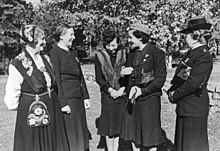Pilar Primo de Rivera
This article needs additional citations for verification. (November 2009) |


María del Pilar Primo de Rivera y Sáenz de Heredia, 1st Countess of the Castle of La Mota (November 4, 1907 – March 17, 1991) was the sister of José Antonio Primo de Rivera, founder of the Falange, a political movement of Spain, and the daughter of Spanish dictator General Miguel Primo de Rivera, 2nd Marquis of Estella.
She was an enthusiastic member of the Falange, heading its Sección Femenina ("Women's Section"). Unlike two of her brothers (both put to death by the Republicans), she survived the Spanish Civil War, during which she met Adolf Hitler, Benito Mussolini, and Antonio Salazar. She attempted to prevent reprisals being taken against the widows of Republican militants, and supported the ascent of King Juan Carlos I in 1975, but was disappointed when the paternalist system – the Spanish State – was dismantled during the Spanish transition to democracy.
Pilar became president of the Association of Sección Femenina Veterans in November 1977, and held the post until her death. The main seat of the association was at the Castle of La Mota.
In addition to her political duties, Pilar carried out a good deal of work compiling numerous different forms of Spanish folklore, specially in the fields of regional music and dances.
She never married. Francisco Franco's foreign minister, Ramón Serrano Súñer, and Ernesto Giménez Caballero, attempted to arrange a marriage between her and Hitler in order to create a fascist dynasty, but this plan never came to fruition.[1]
Genealogy[]
| hideAncestors of Pilar Primo de Rivera y Sáenz de Heredia[2] | |||||||||||||||||||||||||||||||||||||||||||||||||||||||||||||||||||||||||||||||||||||||||||||||||||||||||||||||||||||||||||||||||||||||||||||||||||||||||||||||||||||||||||||||||||||||||||||||||||||||||||||||||||||||||||||||||||||||||||||||||||||||||||||||||||||||||||||||||||||||||
|---|---|---|---|---|---|---|---|---|---|---|---|---|---|---|---|---|---|---|---|---|---|---|---|---|---|---|---|---|---|---|---|---|---|---|---|---|---|---|---|---|---|---|---|---|---|---|---|---|---|---|---|---|---|---|---|---|---|---|---|---|---|---|---|---|---|---|---|---|---|---|---|---|---|---|---|---|---|---|---|---|---|---|---|---|---|---|---|---|---|---|---|---|---|---|---|---|---|---|---|---|---|---|---|---|---|---|---|---|---|---|---|---|---|---|---|---|---|---|---|---|---|---|---|---|---|---|---|---|---|---|---|---|---|---|---|---|---|---|---|---|---|---|---|---|---|---|---|---|---|---|---|---|---|---|---|---|---|---|---|---|---|---|---|---|---|---|---|---|---|---|---|---|---|---|---|---|---|---|---|---|---|---|---|---|---|---|---|---|---|---|---|---|---|---|---|---|---|---|---|---|---|---|---|---|---|---|---|---|---|---|---|---|---|---|---|---|---|---|---|---|---|---|---|---|---|---|---|---|---|---|---|---|---|---|---|---|---|---|---|---|---|---|---|---|---|---|---|---|---|---|---|---|---|---|---|---|---|---|---|---|---|---|---|---|---|---|---|---|---|---|---|---|---|---|---|---|---|---|---|---|---|
| |||||||||||||||||||||||||||||||||||||||||||||||||||||||||||||||||||||||||||||||||||||||||||||||||||||||||||||||||||||||||||||||||||||||||||||||||||||||||||||||||||||||||||||||||||||||||||||||||||||||||||||||||||||||||||||||||||||||||||||||||||||||||||||||||||||||||||||||||||||||||
References[]
| Wikimedia Commons has media related to Pilar Primo de Rivera. |
- Citations
- ^ Francisco Umbral: "Ramón y las vanguardias",El País, 5 August 1985
- ^ Cadenas y Vicent 1955, pp. 598; 597; 607; 608.
- Bibliography
- Cadenas y Vicent, Vicente de (1955). "El marquesado de Estella, el condado de San Fernando de la Unión y el ducado de Primo de Rivera". Hidalguía. Madrid. 3 (12): 593–614.
- 1907 births
- 1991 deaths
- Francoist Spain
- Spanish Falangists
- Spanish Roman Catholics
- Spanish anti-communists
- Spanish countesses
- Primo de Rivera family